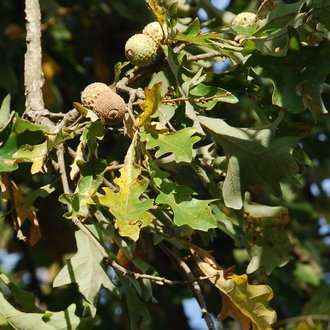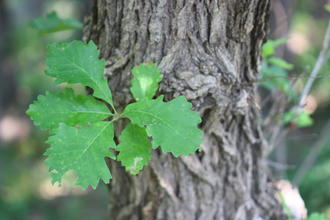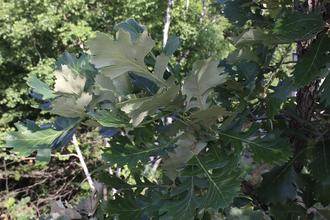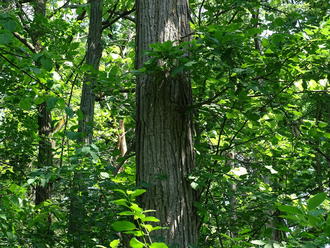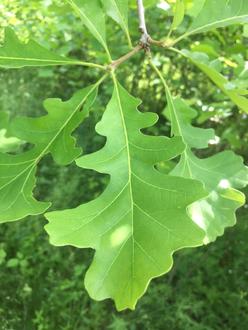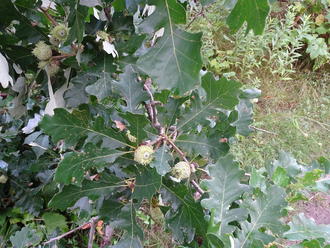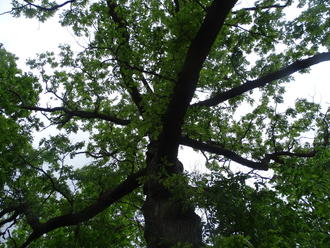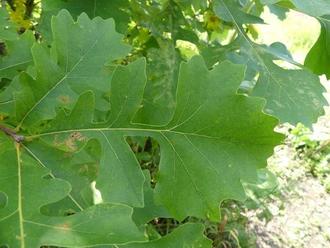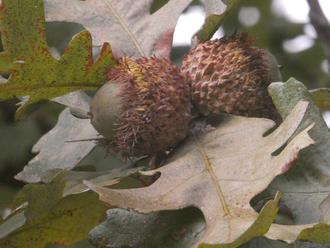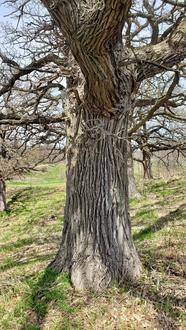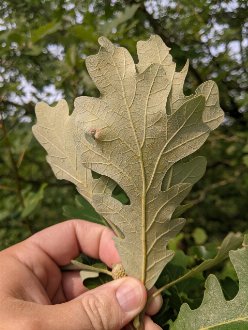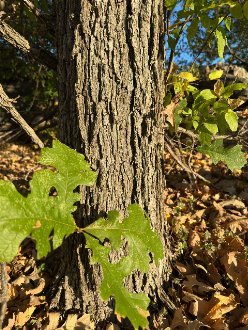Bur Oak (Quercus macrocarpa Michx.)
Also known as mossycup oak, mossy-cup oak, mossycup white oak, prairie oak, mossy-overcup oak.
↑Summary
A rugged oak native to North America, with a wide distribution, ranging farther west and north than most oaks that also occur in the east.
↑Range - Expand
| Legend | Color |
| Native | |
| Native or Not Present | |
| Native or Expanded | |
| Native or Expanded or Not Present |
This map is based on our research. We have checked its accuracy to Level 3 ecoregions. Although this plant occurs somewhere in each of these regions, it may only occur in a small part of some or all of them.
↑Description & Identification
Highly variable in size and other characteristics. Grows to 160ft (50m) in height in moist woodlands, but as a smaller shrub on dry, rocky cliffs.
Mature trees have thick, deeply-grooved bark and a small number of large, thick branches. Especially when growing on open sites, the tree forms large horizontal branches lower on the tree, and ascending branches higher up. In forests, often grows with a more elm-like vase-shape, with large branches curving and ascending. On the harshest sites, the branches take on a gnarled shape.
The leaf shape is highly variable. Most leaves exposed to full sunlight are deeply lobed, often with deep cuts close to the leaf base and shallow cuts close to the leaf tip, leading to a spade-shape at the front of the leaf. Leaves in shade are broad, full, and lack deep lobes, looking similar to those of the closely-related swamp white oak. Leaves grow up to 12 inches (30 cm) long, and have a tough texture, typically a shiny dark green above and covered in silvery hairs beneath.
The acorn cup is very large and encloses more of the acorn than is typical for white oaks, covering at least 1/3rd, often more, and occasionally enclosing the entire acorn. In an opposite trend to many species, acorns tend to be smaller at the southern end of its range.
The root system involves both a deep taproot and wide, spreading roots.
↑Similar Plants
↑Habitat
This species is somewhat of a habitat generalist, with a preference for calcareous soils, which tend to have a higher pH. Other than this preference, it is somewhat of a generalist, adapted to a wide range of conditions and soil textures, but is often found on harsher sites where other large trees cannot thrive.
Found in savannas and prairies as well as bottomland forests, occasionally on dry ridges. The specific habitats where this species occur varies regionally. More common in the midwest, and becoming increasingly uncommon and scattered in the east. Mostly absent from the southeast, which likely reflects high rainfall, leaching of calcium, and accompanying acidic soils.
Among the most cold-tolerant of North American oaks, and ranges the farthest north; can grow in areas with a growing season as short as 100 days. Very tolerant of drought, and slightly tolerant of temporary flooding, but intolerant of prolonged flooding during the growing season.
Other than its preference for calcium and higher pH soils, it seems largely indifferent to soil types, tolerant of well-drained as well as poorly-drained soils, growing on both nutrient-rich soils as well as relatively infertile mineral soils, and tolerating a wide range of adverse textures including poorly-drained clays, and coarse sand and rocky soils.
In the west, in the great plains, this species occupies the driest, most fire-prone sites on which large trees can grow. In much of the great plains, especially where it is the dominant tree, it persists indefinitely only due to frequent burning, its presence often encourages fire, and it can be displaced by other trees if fire is suppressed. However, on the driest sites at the western limits of its range, fire suppression can allow it to colonize prairies as one of the first large tree species. Farther east and on more humid sites, it can be found in areas that do not burn naturally, as a more minor forest component.
↑Life Cycle
Unlike most white oaks which germinate immediately and become established before winter, the acorns of Bur Oak require cold stratification in the northern part of its range, and germinate in spring. However, in the rest of its range, the seeds germinates soon after falling an before winter. Acorns can die if they dry out too much, and do not persist in the seed bank.
The acorns germinate well in exposed mineral soil, with some studies showing that leaf litter actually decreases germination rates, although others showing they increase seedling establishment and survival.
Upon germination, the tree quickly establishes a taproot, but shoots and leaves do not typically emerge until after the winter, or after establishment of an extensive root system for seeds germinating in the spring.
Survival of seedlings, moisture preference, and shade tolerance is governed by many factors and can be wildly variable in different habitats and different parts of its range. In many places, its establishment is aided by drought, as it is highly drought-tolerant and the dry conditions reduce competition from other vegetation. In other regions however, it more easily becomes established in mesic conditions. When invading drier prairies, it is most likely to get established on wetter, more shaded sites. Young trees can be damaged by browsing by deer and livestock.
Growth rate can be wildly variable on different sites, depending on light levels, moisture, and soil fertility.
Established trees are long-lived, often living 300-400 years or even longer. Seed production typically starts around 35 years of age, peaks between 75 and 150 years, but continues as the tree ages. Large seed crops are typically produced every other year. A late frost following a prolonged warm period can hinder seed production by damaging flower buds.
Unlike most oaks, bur oak occasionally produces multi-seeded acorns, usually with 2 seeds but occasionally as many as five. Although a majority of acorns only hold one seed, as many as one-in-five can have two or more seeds, although this characteristic varies by individual tree.
The large, heavy acorns are mostly animal-dispersed, mostly by small mammals and occasionally by blue jays.
Mature trees are highly resistant to fire, due to heavily insulated bark. Younger trees are more vulnerable to being top-killed, although they are more likely to resprout after a fire. Trees begin developing fire resistance when they reach about 3 feet in height. Bur oak leaf litter is slow to decompose and highly flammable; the leaf shape tends to curl and dry out, sitting loosely on the ground, even after a snowy winter. The leaves themselves form a fuel for fire, as well as a mechanism for spreading fire. Woody debris falling from trees is also slow to decay and has a high heat content, also providing fuel for fire.
↑Uses
Planted as a large shade tree and landscaping plant; well-adapted to urban conditions and exposed sites.
The wood is desirable, and has similar properties to other white oaks. It is highly rot resistant, and easy to glue, stain, and finish.
This species has also been used for remediation of coal mining sites, where it has sometimes been able to survive conditions with high soil acidity (as low as 4) and low phosphorus content.
The acorns are considered among the most palatable of oak species, and were historically consumed by Native Americans, and to a lesser degree by early European settlers.
↑Notes
One of the common names, "mossycup oak", references the moss-like appearance of the acorn cup.
↑Links & External Resources
• Bur Oak | The Wood Database (About This Site)
• Bur Oak | Fire Effects Information System (FEIS) (About This Site)
• Quercus macrocarpa (Bur Oak) | Illinois Wildflowers (About This Site)
• Quercus macrocarpa (Bur Oak) | USDA PLANTS Database (About This Site)
• Quercus macrocarpa | Go Botany (About This Site)
• Quercus macrocarpa (Bur Oak) | Missouri Botanical Garden Plant Finder (About This Site)
• Bur Oak | Virginia Tech Dendrology Factsheets (About This Site)
• Bur Oak | Silvics of North America (About This Site)
• Quercus macrocarpa | Biota of North America Project (BONAP) (About This Site)
• Quercus macrocarpa | NatureServe Explorer (About This Site)
• Quercus macrocarpa | Flora of North America (About This Site)
• Bur Oak | Maryland Biodiversity Project (About This Site)
• Quercus macrocarpa Michaux (Bur Oak, Mossycup Oak) | Digital Atlas of the Virginia Flora (About This Site)






